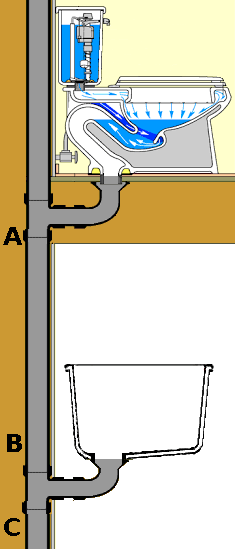Toilet Paper Infarction
Rough old pipes and exuberant toilet papery
 |
When a toilet blocks up, it is because the sturdiest material available is blocking the drain, somewhere. The material might be really impacted feces, but it is probably a huge wad of toilet paper.
A blockage (or a too-brief flick of the handle) means the draining water does not "swirl and suck", the indication of a complete and unblocked flush. One fill from the tank will probably fill the bowl, but not much more, if the blockage is near A. The most likely blockage is near a joint, which makes a gap that can snag toilet paper. A remote possibility is a rough spot on the pipe. If the blockage is near B, then more flushes will be needed to fill it. If the blockage is at C, it will fill the laundry sink downstairs - and worst case, the clothes washer and toilet as well.
Toilet paper eventually dissolves, though it may make a solid plug for an hour or so. Worst case, it dries and forms a permeable plug somewhere down the pipe, and must be cleared out with a snake. But hourly flushes should eventually wear it out.
The cure is using less toilet paper. If you need to use a lot, use a second or third flush. More than about six squares is more likely to block the toilet.
All you have working for you in a toilet is a few inches of pressure head- perhaps a few ounces per square foot, until the material is past the trap and moving down the pipe. That is hardly any pressure at all. And if the blockage is further down, it is more likely to be hammered down by a falling bolus of water though air than by the head of pressure that formed the impaction in the first place. |

